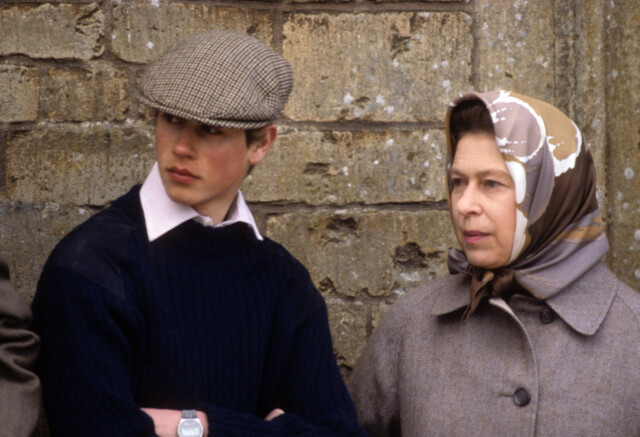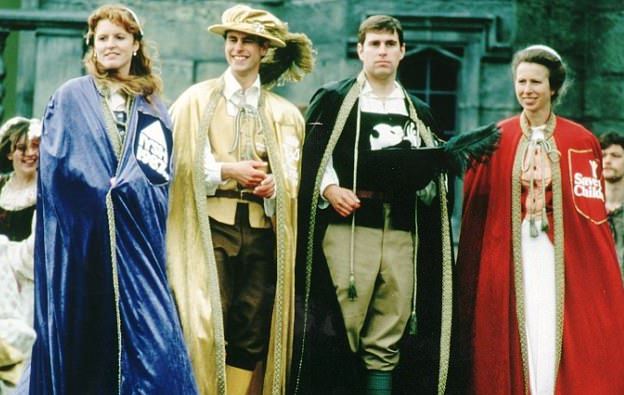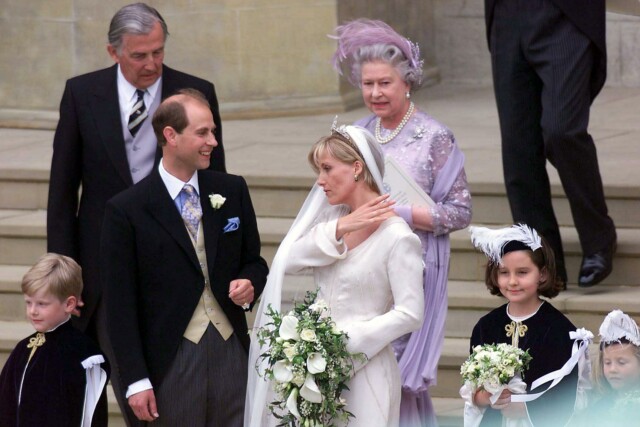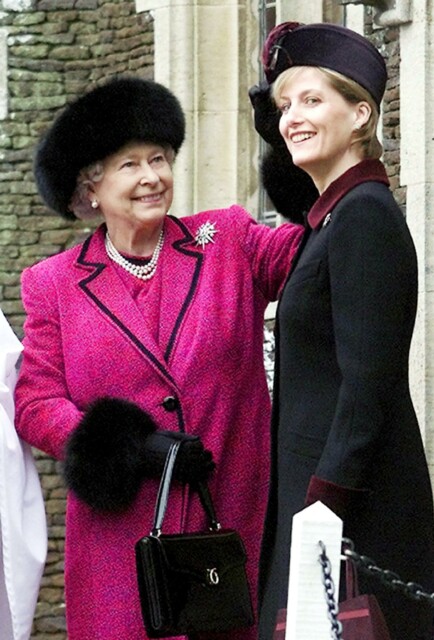
PRINCE Andrew bounded down the gangplank to be presented with a red rose by the Queen on his return from the Falklands War.
She was welcoming him back as a serving Navy hero — and to her, that was what he would always be.
The Queen and Philip with Charles, Edward, Andrew and Anne in 1972
Favourite son Andrew and the Queen in 1967
 The Queen greets Andrew, with a rose between his teeth, on his return from the Falklands in 1982
The Queen greets Andrew, with a rose between his teeth, on his return from the Falklands in 1982
For the rest of her life, the contents of her handbag included a handkerchief, sweeteners in a small gold box and a photo of Andrew taken that day in Portsmouth when he came safely home.
The Prince’s service on HMS Invincible during the 1982 conflict was the pinnacle of his life as an action man in the mould of his naval commander father Prince Philip.
He was the son most like the man Elizabeth loved, and that made him special.
In fact, Philip and Andrew were so alike the family called them, “Identical twins separated in time”.
He was for decades her favourite child, and that made his disgrace after being accused of sexual assault all the harder for her to bear.
Friends and royal experts describe his downfall as the great tragedy of her life.
Andrew was born on February 19, 1960, when the Queen’s other children Charles and Anne were 11 and nine.
Her Majesty, who was 33, wrote to a cousin: “The baby is adorable.
“Both the older children are completely riveted by him and all in all he’s going to be terribly spoilt by all of us, I’m sure.”
The Queen was determined to spend more time with him than she had with Charles and Anne, and courtiers noticed she seemed far more relaxed and affectionate as a mother this time round.
Soon, she would greet official visitors in her study while the toddler Prince played at their feet.
She also gave new nanny June Waller permission to take the youngster out on incognito adventures
June wrote to a friend in March 1963: “One day I took Andrew on a bus!! to Paddington Station to see the trains. He was thrilled to bits and couldn’t see everything fast enough.”
One year later the little boy had a new brother, with Edward’s arrival on March 10, 1964.
Philip was in the delivery room for the first time, after the Queen asked him to be there.
Afterwards, she told a friend: “Goodness, what fun it is to have a baby in the house again!”

Windsor Castle’s Great Corridor soon became a race track for the boys’ pedal cars and bikes, and the Queen’s doctor Sir Cecil Hogg recalled the constant sound of “rampaging” on his visits.
From 1967, they gained another playmate when the Queen invited Philip’s mother, Princess Alice of Battenberg, to move in to Buckingham Palace.
The chain-smoking 83-year-old would bowl balls down the hallway and the boys would whack them back using a hearth brush as a bat.
Andrew was the leader in these exploits, ordering his younger brother about.
He had an arrogant streak that reminded people of his father, and even the Queen admitted: “He is not always a little ray of sunshine.”
Edward was far less brash, with Her Majesty describing him as, “The quietest of my children”.
She taught him to read and write herself, setting up a blackboard in her study.
Both boys were sent to board at Gordonstoun in Scotland for secondary school – the place Charles described as, “Colditz with kilts”.
Girls had been admitted as pupils the year before Andrew arrived, and Charles noted: “He’s enjoying himself immensely.”
Edward, meanwhile, was remembered by fellow students because he “didn’t ram who he was down your throat” — unlike Andrew.
The Queen was thrilled when Andrew joined the Royal Navy in 1979 to train as a helicopter pilot, as his father had done before him.
When war broke out with Argentina over the invasion of the Falkland Islands in April 1982, Prime Minister Margaret Thatcher set about hustling Andrew into a desk job to keep him safe.
‘Identical twins separated in time’
He was, after all, second in line to the throne. But Andrew hit the roof, and the Queen stepped in.
He once said: “There was no question in her mind, and it only took her two days to sort the issue.”
Soon he was sailing away aboard the aircraft carrier HMS Invincible, which became a key target for Argentine bombs.
Andrew later admitted he had been left traumatised by flying his helicopter as a decoy to draw Exocet missiles away from the ship, and by being told to, “hit the deck because the ship is under attack”.
But when the 22-year-old cruised back into Portsmouth Harbour in September that year with the war won, he looked every inch the carefree hero.
Edward seemed set to follow in his brother’s footsteps, joining the Royal Marines in 1986 after graduating from Cambridge.
Earlier that year, the Prince had asked West End supremos Andrew Lloyd Webber and Tim Rice to write a musical for the Queen’s 60th birthday.
The resulting show, called Cricket, had its one-off performance at Windsor Castle with a cast including glam rocker Alvin Stardust and Chariots Of Fire star Ian Charleson, as well as Edward as a “gallant last batsman”.
For theatre-mad Edward it was dizzying.
In January 1987, four months after beginning his training with the Marines, he announced he was quitting the military.
The Queen was “livid”, but Edward had fallen in love with showbiz and wanted to be a producer.
By the middle of 1987, the Queen was supportive enough of his new career to go along with one of the worst ideas ever hatched: A TV spectacular known as It’s A Royal Knockout.
One of the Queen’s friends later admitted: “It was a terrible mistake. She was against it. But she could not say no to Edward.”
Filmed at Alton Towers, the BBC show featured Edward, Andrew, Anne and Andrew’s new wife Sarah Ferguson in Tudor costumes cheering on their teams of celebrities in slapstick games.
Tom Jones pelted Toyah Willcox with fake hams; Pamela Stephenson tackled Cliff Richard while he was dressed as a giant leek; and Chris de Burgh climbed a damsel’s tower in sopping-wet satin tights.
It was a PR disaster, and even on the day, only the Duchess of York seemed to enjoy herself.
She had married Andrew the year before, and her jolliness was what the Queen liked best about her, especially after dealing with the highly strung Diana.
A friend said years later: “She liked the way she used to sit with her legs apart, making jokes.”
The relationship ended in divorce in 1996. Five years later, Andrew left the Navy and became a UK trade envoy.
But he left the role in 2011 after it was revealed he had kept up his friendship with Jeffrey Epstein after the US financier’s conviction for child sex abuse.
Over the next years, Andrew was himself accused of having sex with a 17-year-old girl allegedly trafficked by Epstein, and in November 2019 he stepped down from royal duties.
The move followed a car-crash Newsnight interview, and courtiers blamed the Queen for not over-ruling his decision to go on TV.
Once again she had not been able to say no to one of her sons.
In 2022, as civil action over Andrew’s alleged sexual misconduct continued, his military titles and royal patronages were returned to the Queen and it was announced he would no longer be known as His Royal Highness.
‘Heartbroken’
His disgrace was particularly painful because as the Duke of Edinburgh’s health failed, the son who was most like him had been lined up to take over as consort, accompanying the Queen on engagements.
Friends described the Queen as “heartbroken” at losing him from her side in public.
But in private he remained a favourite.
An aide recalled: “Whenever she heard Andrew was by himself at Buckingham Palace, she sent him a handwritten note and he’d change into a suit to go up and see her.
“He’d greet her with a bow, kissing her hand and both her cheeks. It’s a little ritual that she adores.”
She also loved the happy family atmosphere his daughters Beatrice and Eugenie brought to Royal Lodge at Windsor, where she had spent much of her childhood.
She even let Beatrice redecorate her beloved childhood Wendy house.
But it was youngest son Edward who gave the Queen the most important gift of her last years: The friendship of Sophie, Countess of Wessex. He had married the PR boss in 1999.
Kind, warm and relaxed, Sophie became one of Her Majesty’s closest confidantes.
The Queen described her as: “The perfect royal.”
Sophie even convinced Her Majesty to sit down with herself, Edward and children Louise and James to watch TV’s The Crown, although the Queen kept interrupting to complain about what the show got wrong.
They became even closer after the Duke’s death, with the Countess noting: “I think it must be a fairly lonely place being the Queen.”
As for Edward, with the Queen’s blessing, Prince Philip asked if he would take the title of Duke of Edinburgh after he and the Queen passed away.
It was a title that Andrew had long been expected to take.
And for the Queen, it was the greatest honour she could ever bestow.
 Prince Andrew and baby Edward join their parents on the Palace balcony for Troopingthe Colour in 1964
Prince Andrew and baby Edward join their parents on the Palace balcony for Troopingthe Colour in 1964
 Prince Edward and the Queen depart from Liverpool train station in 1965
Prince Edward and the Queen depart from Liverpool train station in 1965
 Edward and the Queen at the Badminton Horse Trials in 1980
Edward and the Queen at the Badminton Horse Trials in 1980
 Military life as Edward is pictured in his Marines uniform in 1984
Military life as Edward is pictured in his Marines uniform in 1984
 Fergie, Edward, Andrew and Anne on the 1987 Knockout telly gameshow
Fergie, Edward, Andrew and Anne on the 1987 Knockout telly gameshow
 Edward marries Sophie in 1999
Edward marries Sophie in 1999
 The Queen straightens Sophie’s hat before Christmas Day service in 2002
The Queen straightens Sophie’s hat before Christmas Day service in 2002







